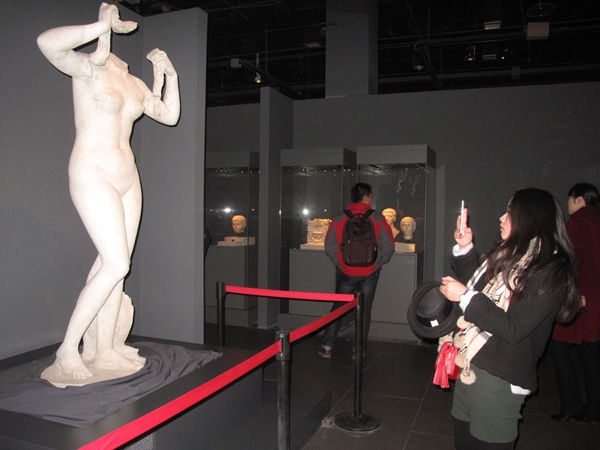 |
|
A visitor takes a photo of the Statue of Venus in the exhibition. [Photo by Huang Zhiling/chinadaily.com.cn] |
Visitors to the Jinsha Site Museum in Chengdu, Sichuan province are in for a treat, as priceless cultural relics from ancient Rome in Italy are on display in the exhibition "The Eternal City, Splendor of Ancient Rome."
"I didn't expect to see so many fine relics from the Roman Empire which I had only seen in books and on TV," said Liang Zhao, a smiling 28-year-old resident from Taiyuan, Shanxi province on Wednesday.
Borrowed from Italian museums by the Jinsha Site Museum, Tianjin Museum, Shandong Museum and Yunnan Museum, 233 pieces (sets) of cultural relics of ancient Rome will be on display in the Jinsha Site Museum till April 8 on the first leg of their China tour.
The next three legs will be in Tianjin municipality and Shandong and Yunnan provinces.
Rome, set up in 753 BC, is known as the eternal city. Some of the most impressive monuments of antiquity are standing along its busy, modern streets bearing silent witness to the vicissitudes of history.
Rome was not built in a single day, but over the course of many centuries.
To present the ancient Roman civilization to Chinese audiences, organizers are exhibiting the relics of ancient Rome collected in museums including Palatine, Coliseum, Domus Aurea, National Roman Museum, Baths of Diocletian, Palazzo Massimo, Siena Archaeological Museum and National Archaeological Museum of Florence.
"Many of the exhibits are being shown in China for the first time. The insurance for all the relics is nearly 100 million yuan ($15 million)," said Huang Yujie, an official in charge of relic display in the Jinsha Site Museum.
Parallel to the history of the Roman Empire from the first century BC to the fourth century, the exhibition follows a chronological progression along a symbolic route stretching from the Imperial Forums of Caesar Augustus to the Arch of Constantine.
All the objects in the exhibition are meant to reconstruct the lives and everyday scenes of the Romans from the emperor to the intellectuals and ordinary people over a period of 500 years, organizers said.
